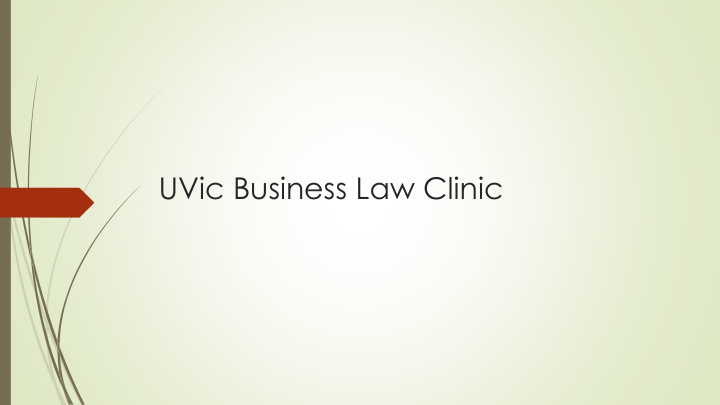



UVic Business Law Clinic
Disclaimer The Business Law Clinic (the “BLC”) is pleased to provide general legal information related to your queries. Please note that this information is for reference purposes only since, as law students, we are not licensed to provide legal advice. If you wish to pursue any course of action based on the information contained within this presentation, it is advisable to speak first to a licensed lawyer practising in British Columbia.
Who we are A group of students at the University of Victoria, Faculty of Law Interested in the practice of Business Law
What we do Provide free legal information to anyone with a business-related issue Legal information is: General information related to a particular legal topic What we don’t do… Provide legal advice Litigation-related issues Legal advice is: Legal guidance that is specific to an individual client’s particular set of circumstances
Who we help Past clients include Local business people Business owners Entrepreneurs Non-profit organizations
The process 1. Contact the Business Law Clinic (BLC) 2. Schedule an interview with a BLC student 3. Receive a memo of legal information 4-6 weeks later
How to contact Phone: 250-472-4522 Email: blc@uvic.ca
Types of Business Associations Advantages and Disadvantages of Different Forms
Sole proprietorships Simple business form Just start conducting business Legally, the business and the owner are one and the same
Sole proprietorships Advantages Disadvantages Simple – no action required Not a separate legal entity The ultimate decision-maker Unlimited personal liability Name limitations Flexibility Must be unique Not a separate legal entity Must not confuse/mislead Tax benefits Unprotected unless trademarked
General partnerships Formed when two or more persons start carrying on business together Governed by a default set of rules unless altered by agreement The Partnership Act
General partnerships Advantages Disadvantages Ease of formation Ease of formation Inexpensive Not a separate legal entity Share the business Unlimited personal liability Liable for partner’s acts Limited regulation Bound by partner’s business Not a separate legal entity decisions Tax benefits Ease of dissolution Ease of dissolution
Incorporation A separate legal entity Arises from a formal process of incorporation Flexible form of business association
Incorporation Advantages Disadvantages Separate legal entity Separate legal entity Limited Liability Can’t deduct losses against personal income Tax advantages Closely regulated If profitable Record keeping Flexible ownership structure Cost Perpetual existence Personal Guarantees Ease of transfer of business
Steps of incorporation 1. Sign an incorporation agreement 2. Create or adopt a set of articles 3. Submit the incorporation application 4. Maintain incorporation documents 5. Other records
Any questions so far?
Contracts: The Basics
What is a contract? Legally enforceable mutual promise Requires: Offer Acceptance Consideration
1. Offer One party expressing an intent to enter into a legally binding agreement Ex. Mike offers to sell Joe an apple for $1 A general advertisement is NOT an offer – not legally binding Ex. Mike advertises that he is selling apples for $1
2. Acceptance A person who receives an offer has the power to accept that offer Ex. Once Mike offers Joe an apple for $1, Joe has the power to accept the offer However, the person making the offer can determine the manner in which the offer must be accepted Ex. Mike offers Joe an apple for $1, and says Joe must accept the offer in writing
3. Consideration Consideration can be anything of “value” Ex. $1, walnut, apple, flowers, etc. Without consideration, the exchange is not a contract It is a gift Ex. Mike promises to give Joe an apple tomorrow, but changes his mind. Mike is not legally bound to give Joe the apple because it was merely a gift.
Means of communication: offer & acceptance In writing Orally By conduct
Communication in writing Advantages Creates reliable records Clearly expresses intention of both parties Allows sufficient opportunity to review Best practice in the majority of circumstances Disadvantages Lengthy Difficult to understand Formal
Oral communication Advantages Quick and easy Informal Disadvantages Unreliable (he said, she said) Difficult to enforce
Communication by conduct Special way of communicating offer or acceptance Even if you don’t formally accept, certain actions may be deemed as acceptance Implicit acceptance by conduct Ex. Mike offers Joe an apple for $1, and Joe takes the apple Acquiesce Ex. Joe takes the apple and leaves $1 for Mike, who does not object (acquiescence) but later accuses Joe of stealing the apple
Scenarios Mike has a sign that says “Apples for $1”, Joe takes an apple and gives Mike $1. Mike returns the $1 and says “Give me my apple back, I’m not selling them anymore” Mike offers Joe an apple for $1, Joe says he accepts the apple in exchange for $0.50 Mike offers Joe an apple for $1, Joe says he doesn’t have $1 and asks if Mike would exchange the apple for a bundle of grapes instead. Mike accepts.
Standard Form Contracts
Standard form contracts What is a standard form contract? Terms and conditions are set by one party on a “take it or leave it” basis E.g. Agreeing to Facebook’s terms Signing a waiver Business to business
Standard form contracts Advantages Efficient Facilitates business transactions Disadvantages Imbalance of bargaining power May unintentionally bind yourself to terms of a contract
Special features If there is ambiguity, contract is read against the drafter Signature does not necessarily bind signor Limited circumstances Special attention must be drawn to terms affecting legal rights Waiver of liability Release of right to bring legal action
Discussion
Recommend
More recommend